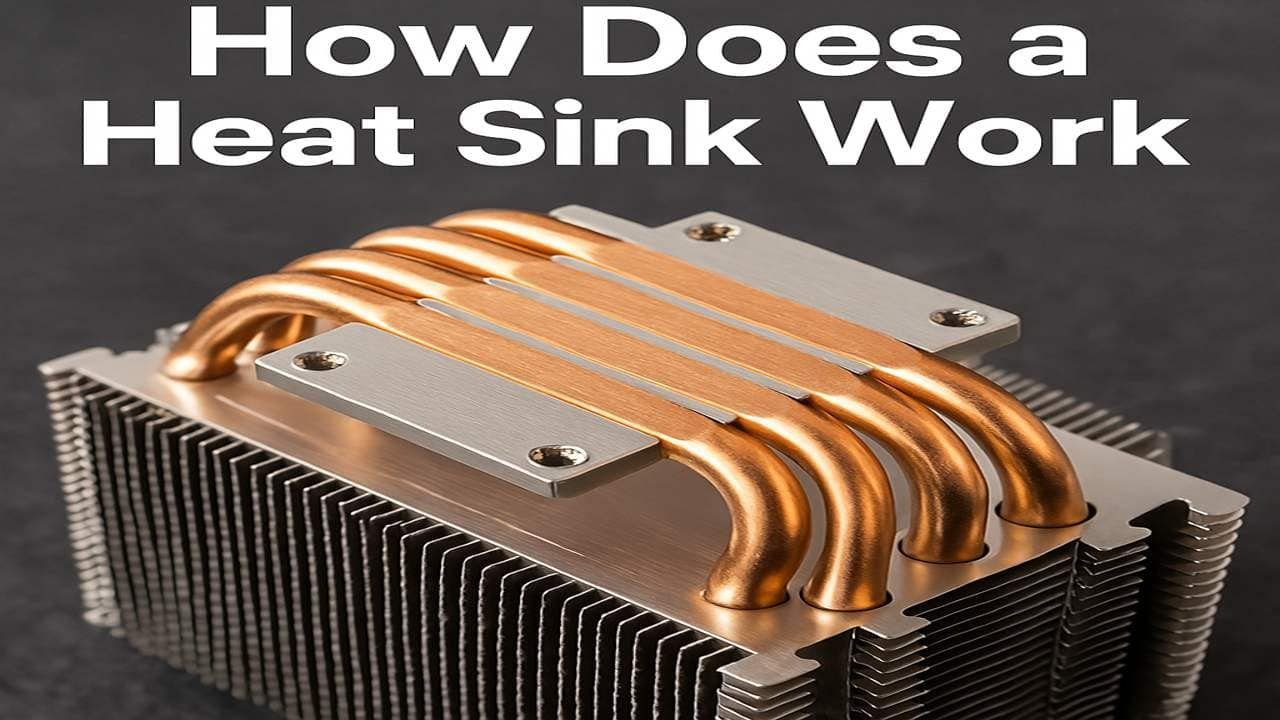It’s not only one but several cooling systems that manage the temperature of electronic components. This usually includes TIMs, heat sinks, liquid coolers, and cooling fans. In some components, there is a combination of all, while in some, only specific ones are used. If we talk specifically about the heat sink, it uses a combination of thermal paste and air fans.
A heat sink is a source of heat transfer from inside to outside the components. In today’s ultimate guide, we will look into the various factors related to heat sinks. How does a heat sink work? What are the known types of heat sinks? Which sort of material is used in heat sinks? What are the applications of a heat sink? So, let’s move forward towards the discussion.
What is a Heat Sink?
A combination of base plate, heat pipes, and fins is known as a heat sink. It functions to transfer the heat generated by components to outside the components. Heat sinks can be used in a variety of components from low to high-end. It helps to maintain an optimal temperature and avoid overheating components. This results in improving the performance and lifespan of the components.
- Base Plate: A base plate is the bottom of the heat sink made up of copper & aluminum. It gets attached to the heat-generating component during installation. The thermal paste in between the base plate & component transfers the heat towards the base plate.
- Heat Pipes: The heat pipes are metal tubes made from highly conductive copper & aluminium. These pipes contain some amount of liquid inside them and function effectively to transfer the heat from components.
- Heat Sink Fins: Fins are an extra part attached to heatsinks to gain more surface area for better airflow and heat transfer. These cooling fins come in different shapes and sizes as per the requirement of a component.
How Does A Heat Sink Work?
Generally, a heat sink operates following three major fundamentals. It includes conduction, convection, and radiation. In simple terms, it refers to heat generation, heat absorption, and heat dissipation. If not performed accordingly, it may result in overheating or internal damage to the components.
- Conduction: In this process, the heat generated by components reaches the base plate, heat pipes, and, finally, the fins of the heatsink.
- Convection: In this process, the heat from the heat sink is thrown outside following a natural or forced convection system.
- Radiation: In this process, a small amount of heat in the form of electromagnetic energy transfers from the heat sink to the outside.
Manufacturing Material
Heat Sinks are made up of a combination of high-class Copper plus Aluminium. Because it requires higher conductive attributes to perform the heat dissipation job. Otherwise, the cooling system will not operate up to standard to manage the heat generation.
- Copper: A reliable and durable option than various metals. It features a thermal conductivity range of 400 W/mK. Most of the heat sinks utilize copper as a manufacturing ingredient.
- Aluminium: Similarly, aluminium is also a reliable, durable, and budget-friendly option to choose from on the list. It provides great electrical insulation plus a thermal conductivity of 237 W/mK.
Major Types
Below are the major types of heat sink,
1: Passive Heat Sinks
In order to manage low-end cooling tasks, passive heat sinks are preferred. These heat sinks function based on natural convection, including fins & heat sinks. There is no contribution of cooling fans or any other moving source, these heat sinks operate silently.
2: Active Heat Sinks
Similarly, in order to manage high-end cooling tasks, active heat sinks are preferred. The functionality of these heat sinks is based on forced convection. It involves the contribution of cooling fans or a liquid cooling system to dissipate the heat outside the environment.
3: Hybrid Heat Sinks
A combination of the working mechanisms of both passive and active heat sinks leads towards hybrid heat sinks. In this case, heat sinks function in passive mode up to a certain limit. Then, it adopts an active mode when that limit is reached. Finally, the heat is managed accordingly.
Major Applications
- Computers: CPUs, GPUs, Motherboards, and Power Supplies (PSUs).
- Consumer Electronics: Mobiles, Xbox, PlayStation, and Nintendo Switch.
- Automotive Industry: Vehicle Computers (ECU), EV Batteries, and Vehicle Headlights.
- Medical Industry: Lab Equipment, MRI, CT-Scan, and X-Ray Machines.
- Telecommunication Industry: Satellite, 5G Infrastructure, and Base Stations.
- Industrial Machinery: Motor Drives, Converters/Inverters, and Laser/Welding Machines.
Pros & Cons of Heat Sink
– Pros:
- Heat Sinks are easy to afford.
- Heat Sinks are a good source of heat management.
- Heat Sinks are available in different shapes and sizes.
- Heat Sinks are easy to install & maintain.
- Heat Sinks are reliable and durable.
– Cons:
- Heat Sinks are not for compact size cases (if using for PC)
- Heat Sinks are noisy if used with cooling fans.
- Heat Sinks are not energy efficient (if using large-sized heat sinks)
JiuJu‘s Heat Sinks
JiuJu proudly owns the credit for manufacturing quality heat sinks and related TIMs. Our highlighted thermal management products are Thermal Pads, Thermal Paste, and Thermal Gel.
For other related products, visit our products page; it has a lot for you. We have advanced manufacturing machinery, an experienced team/scientists, and organized storage compartments.
Moreover, our shipping partners are also renowned names in their domain. Currently, we have long-term business relationships with more than 500 clients. Apart from this, the monthly production capacity at JiuJu is more than 20 tons.
So, if you are searching for a reliable and reputable manufacturer. Give a chance to JiuJu for buying top-quality products. We assure you that you will never regret buying from us. Click on this link and get counselling about the products.
We offer wholesale rates to those who buy our products in bulk. Apart from this, we offer discounted rates and other perks to new customers. Don’t be so late, and reach us today with your requirements and get the relevant quotation.
Final Verdict
One can not deny the solid contribution of heat sinks in dissipating the heat. They are not only a good source of thermal conductivity but also improve the lifespan of components. Heat sinks are available in multiple sizes with multiple patterns of cooling fins.
Talking about the types, the passive heat sinks are effective for low-level tasks. Similarly, active heat sinks are the only choice for high-end tasks. If one wants to have a mixture of both types, nothing could outperform the hybrid heat sinks.
Heat sinks offer a wide variety of applications in electronics, automotive, and industry equipment. Make sure to choose the heat sink and its type as per the requirement of your component. It is a budget-friendly cooling solution with long-term outcomes.
Don’t miss the chance to get TIMs at discounted rates from JiuJu. There is a lot more for bulk buyers.





